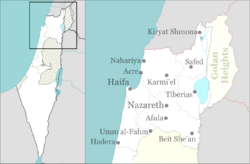Nazareth facts for kids
Quick facts for kids
Nazareth
النَّاصِرَة, an-Nāṣira
נָצְרַת, Nāṣrat
|
||
|---|---|---|

View of Nazareth, with the Basilica of the Annunciation at the center
|
||
|
||
| Country | ||
| District | Northern | |
| Founded |
|
|
| Municipality | Est. 1885 | |
| Government | ||
| • Type | Mayor–council | |
| • Body | Municipality of Nazareth | |
| Area | ||
| • Total | 14.123 km2 (5.453 sq mi) | |
| Elevation | 347 m (1,138 ft) | |
| Population
(2017)
|
76,551 | |
| Demonym(s) | Nazarene | |
| Ethnicity | ||
| • Arabs | 99.8% | |
| • Jews and others | 0.2% | |
| Time zone | UTC+2 (IST) | |
| • Summer (DST) | UTC+3 (IDT) | |
| Area code | +972 (Israel) | |
Nazareth (/ˈnæzərəθ/ naz-ƏR-əth; Arabic: النَّاصِرَة, romanized: an-Nāṣira; Hebrew: נָצְרַת, romanized: Nāṣəraṯ; Syriac: ܢܨܪܬ, romanized: Naṣrath) is the largest city in the Northern District of Israel. In 2017 its population was 76,551. Known as "the Arab capital of Israel", Nazareth serves as a cultural, political, religious, economic and commercial center for the Arab citizens of Israel. The inhabitants are predominantly Arab citizens of Israel, of whom 69% are Muslim and 30.9% Christian. The city also commands immense religious significance, deriving from its status as the hometown of Jesus, the central figure of Christianity and a prophet in Islam.
Findings unearthed in the neighboring Qafzeh Cave show that the area around Nazareth was populated in the prehistoric period. Nazareth was a Jewish village during the Roman and Byzantine periods and is described in the New Testament as the childhood home of Jesus. It became an important city during the Crusades after Tancred established it as the capital of the Principality of Galilee. The city declined under Mamluk rule, and following the Ottoman conquest, the city's Christian residents were expelled, only to return once Fakhr ad-Dīn II granted them permission to do so. In the 18th century, Zahir al-Umar transformed Nazareth into a large town by encouraging immigration to it. The city grew steadily during the late 19th and early 20th centuries, when European powers invested in the construction of churches, monasteries, educational and health facilities.
Since late antiquity, Nazareth has been a center of Christian pilgrimage, with many shrines commemorating biblical events. The Church of the Annunciation is considered one of the largest Christian sites of worship in the Middle East. It contains the Grotto of the Annunciation, where, according to Catholic tradition, angel Gabriel appeared to Mary and announced that she would conceive and bear Jesus. According to Greek Orthodox belief, the same event took place at the Greek Orthodox Church of the Annunciation, also known as Church of Saint Gabriel. Other important churches in Nazareth include the Synagogue Church, St. Joseph's Church, the Mensa Christi Church, and the Basilica of Jesus the Adolescent.
Etymology
Hebrew Netzer
One view holds that the name 'Nazareth' is derived from one of the Hebrew words for 'branch', namely ne·ṣer, נֵ֫צֶר, and alludes to the prophetic, messianic words in Book of Isaiah 11:1: "from (Jesse's) roots a Branch [netzer] will bear fruit". One view suggests this toponym might be an example of a tribal name used by resettling groups on their return from exile. Alternatively, the name may derive from the verb na·ṣar, נָצַר, 'watch, guard, keep", and understood either in the sense of 'watchtower' or 'guard place', implying the early town was perched on or near the brow of the hill, or, in the passive sense as 'preserved, protected' in reference to its secluded position. The negative references to Nazareth in the Gospel of John suggest that ancient Jews did not connect the town's name to prophecy.
Greek Nazara
Another theory holds that the Greek form Ναζαρά (Nazará), used in the Gospel of Matthew and Gospel of Luke, may derive from an earlier Aramaic form of the name, or from another Semitic language form. If there were a tsade (צ) in the original Semitic form, as in the later Hebrew forms, it would normally have been transcribed in Greek with a sigma (σ) instead of a zeta (ζ). This has led some scholars to question whether "Nazareth" and its cognates in the New Testament actually refer to the settlement known traditionally as Nazareth in Lower Galilee. Such linguistic discrepancies may be explained, however, by "a peculiarity of the 'Palestinian' Aramaic dialect wherein a sade (ṣ) between two voiced (sonant) consonants tended to be partially assimilated by taking on a zayin (z) sound".
Arabic an-Nāṣira
The Arabic name for Nazareth is an-Nāṣira, and Jesus (Arabic: يَسُوع, romanized: Yasū') is also called an-Nāṣirī, reflecting the Arab tradition of according people an attribution, a name denoting whence a person comes in either geographical or tribal terms. In the Qur'an, Christians are referred to as naṣārā, meaning "followers of an-Nāṣirī", or "those who follow Jesus of Nazareth".
See also
 In Spanish: Nazaret para niños
In Spanish: Nazaret para niños




